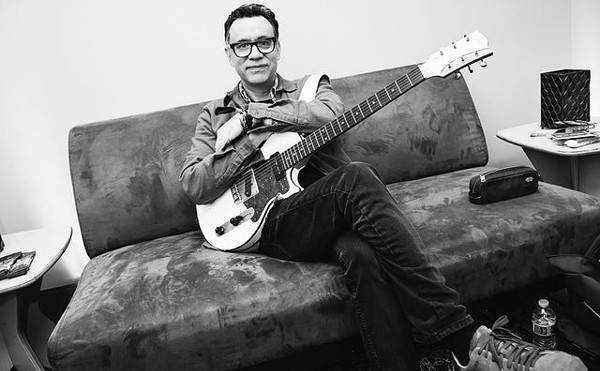Struggle defines not only the content of Travis Kinchy's work, but also the circumstances that produced it. The 32-year-old artist has worked without acclaim, without publicity and without constructive criticism from his peers. Those who have seen his art have only done so through personal invitations to the artist's home or iPhone photos circulated by a small circle of supporters. The sculptures into which he has poured a third of his life have never been exhibited.
Yet he sculpts, because there is no other vocation for him.
"I can't stop. If I could, I would have years ago and my life would have been so much easier. But that's not what I have ever wanted. I'm an artist," he says.
When he was 20, Kinchy ditched studying at the Netherlands' Utrecht School of Arts for firsthand knowledge of Europe's museums. At the Louvre and Accademia di Belle Arti Firenze, he stood for the first time front of the works of Michelangelo. He found them more worldly than he expected.
He saw the legendary "David," wreathed in scaffolding and dusted in cobwebs. In the writhing marble form of the "Dying Slave," he saw centuries-old chisel marks.
Seeing these imperfections and marks of the endless workaday activities that made statues was an epiphany for Kinchy. The objects disclosed themselves as things shaped by a man's skill, not untouchable Platonic forms. "Dying Slave" taught Kinchy even divine icons are still things which people make.
"It's a photograph in stone of an actual human being who did it," Kinchy says.
Realizing the possibility of making something profound and immortal steeled Kinchy to his own career sculpting. Today, about a dozen clay figures line the walls of his home's foyer-studio.
In "Death of the Steel Driver," folk hero John Henry makes a gesture like a bow as he clutches his failing heart. "Sermon" presents a towering, brooding man raising a hand in sad chastisement. The flaming-haired man who is "A Lonely Star" swoons as if in grief.
Struggle unites all of Kinchy's figures. He wants to make art that connects with audiences by depicting the strains of intolerable hardship, which he believes all viewers recognize.
"Buddhists believe that life is suffering, but we're still happy we're here. Even if you don't know anything about art, you've suffered," Kinchy says.
Kinchy doesn't display because he doesn't think his works are done. His clay sculptures, however detailed and haunting they are, are only prototypes for bronzes Kinchy hopes to cast. Displaying them seems to Kinchy a disservice.
"It's almost like showing sketches of a painting, [or] like going to a concert where a violinist hands out sheet music and just leaves," Kinchy says. For him, the alloy is alive like no other material.
"There's a fluidity to it. There's a warmth you don't quite get in stone, unless you're very good with stone," he says.
In 2010, a local foundry gave Kinchy an estimate for the cost of molding and casting his statues. The smallest piece — about 2-foot tall — would be about $1,900, and the largest — 7-foot tall — would cost $25,000. Given inflation, both those figures are doubtlessly higher now. Kinchy, who works odd jobs — construction, house painting, graphic design commissions — has never been able to save up what he needs.
Besides economics, Kinchy is trudging against a plurality of the art world's tastes. He learned this when he took his first and only sculpture class at the University of Akron, where instructors embraced anti-representational trends prevalent in contemporary academic art. Kinchy's sculpture teacher told his class that they could make anything they wanted, except a figure. Kinchy made figures anyway.
"She basically told me she would give me a D-minus as long as I never took a class with her again," Kinchy says.
Even the artist's own materials have proven unreliable collaborators. Like any big object, Kinchy's sculptures strain under gravity. The clay he uses cracks under its weight and can get dangerously soft in summer heat. By Kinchy's estimation, the figures standing in his studio represent only about half of the works he's completed. The rest, despite his diligent maintenance, have fallen apart.
"It breaks my heart," Kinchy says.
However, this summer might finally offer Kinchy something other than more ruined sculptures. Last year, a mutual friend introduced Kinchy to Joe Ayala and Daniel Neforos, respectively the former and current gallery directors with the Cleveland West Arts League. Visiting his studio, the two immediately became advocates.
"I was taken aback by how unbelievably beautiful and professional these works are. I was just at a loss for words," says Ayala. "One thing I could say to him was, 'How have you never shown? You've got to get this out there.'"
This March, Ayala and Neforos invited a handful of Cleveland art scene personalities (the author included) to an "open studio" in Kinchy's home-workspace. They've introduced him to another curator, scouted exhibit locations and nudged him into submitting clay figures or drawings for exhibition.
"I told him he has to have an open mind if you want to get your name out there. You've got to start with something. We can do whatever we can for him, but it's up to him to take the advice we give him and push it forward," Ayala says.
Kinchy says he's coming around to displaying his drawings and illustrations, and recently put up his first online portfolio at traviskinchy.com. Despite all the work behind him, these are only first steps along a long and rough route ahead. But Kinchy doesn't think himself alone on that course.
"I'm not sure if an artist has to suffer for their art, but it seems everyone does," Kinchy says.











